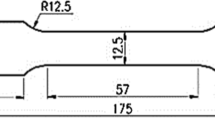Abstract
In the recent automobile era, SAE 1022, low carbon manganese steel is widely used in structural members of automobiles. These steels possess good weldability and need proper heating treatment conditions when high thickness sections are being used in the structural application. Mostly, gas metal arc welding (GMAW) is preferred in automobile industries to have which produces better penetration with some minor defects like improper fusion of sidewall, etc. The increasing demand in the field of the automobile led to the attention over automated GMAW is being preferred to reach better productivity with zero defects. The samples were welded by the conventional GMAW method and automated through a robot. From the experimental test results, welding current of 450A, welding speed of 350 mm/min and a land height of 4 mm yielded a maximum tensile strength of 647 MPa and hardness of 275 HV in the coarse-grained heat-affected zone region with a robotic mode of GMAW. The comparative study proved that automated process produced better mechanical properties and improved efficiency.





Similar content being viewed by others
References
S.Q. Moinuddin, A. Kapil, K. Kohama, A. Sharma, On process–structure–property interconnection in anti-phase synchronized twin-wire GMAW of low carbon steel. Sci. Technol. Weld. Join. 21(6), 452–459 (2016)
K. Abbasi, S. Alam, M.I. Khan, An experimental study on the effect of MIG welding parameters on weld bead shape characteristics. IRACST – Eng. Sci. Technol. 2(4), 599–602 (2012)
K.R. Carpenter, B.J. Monaghan, J. Norrish, Analysis of fume formation rate and fume particle composition for gas metal arc welding (GMAW) of plain carbon steel using different shielding gas compositions. ISIJ Int. 49, 416–420 (2009)
O. Kermorgant, A magnetic climbing robot to perform autonomous welding in the shipbuilding industry. Robot. Comput. Integr. Manuf. 53, 178–186 (2018)
D. Skarin, J. Nilsson, D. Green, Robotic equipment for MIG welding. MIG Weld Guide, (Woodhead Publishing, 2006) pp. 221–262
E.A. Gyasi, P. Kah, H. Wu, M.A. Kesse, Modelling of an artificial intelligence system to predict structural integrity in robotic GMAW of UHSS fillet welded joints. Int. J. Adv. Manuf. Technol. 93, 1139–1155 (2017)
Y. Xu, J. Zhong, M. Ding et al., The acquisition and processing of real-time information for height tracking of robotic GTAW process by arc sensor. Int. J. Adv. Manuf. Technol. 65, 1031–1043 (2013)
Zakaria Boumerzoug, Chemseddine Derfouf, Thierry Baudin, Effect of welding on microstructure and mechanical properties of an industrial low carbon steel. Engineering 2(7), 502–506 (2010)
A.G. Olabi, M.S.J. Hashmi, The microstructure and mechanical properties of low carbon steel welded components after the application of post weld heat treatments. J. Mater Proc. Technol. 38(10), 88–97 (1996)
K.U. Lailesh Kumar, Sudipta Pramanik Yazar, Effect of fusion and friction stir welding techniques on the microstructure, crystallographic texture and mechanical properties of mild steel. Mater. Sci. Eng., A 754, 400–410 (2019)
M.M. Hosseinouin et al., Investigation on multi-run metal made of HSLA steel- heterogeneous microstructure and mechanical properties. Mater. Test. 59(7–8), 661–672 (2017)
I. Kim, J. Son, S. Lee, P.K.D.V. Yarlagadda, Optimal Design of neural networks for control in robotic arc welding. Robot. Comput. Int. Manuf. 20, 57–63 (2004)
E.A. Gyasi, P. Kah, H. Wu, M.A. Kesse, Modeling of an artificial intelligence system to predict structural integrity in robotic GMAW of UHSS fillet welded joints. Int. J. Adv. Manuf. Tech. 93, 1139–1155 (2017)
Y. Xu, J. Zhong, M. Ding et al., The acquisition and processing of real-time information for height tracking of robotic GTAW process by arc sensor. Int. J. Adv. Manuf. Tech 65, 1031–1043 (2013)
N. İpek, F. Elaldi (2012). Analysis of welding groove angle and geometry on strength of armor steel, Mater. Manuf. Process. 1437–1441
Acknowledgements
The authors extend thanks to Automotive Axles Limited—Mysore, India, for their extreme support toward the presented research work.
Author information
Authors and Affiliations
Corresponding author
Additional information
Publisher's Note
Springer Nature remains neutral with regard to jurisdictional claims in published maps and institutional affiliations.
Rights and permissions
About this article
Cite this article
Rajakumar, S., Vimal Kumar, P., Kavitha, S. et al. Mechanical and Microstructural Characteristics of Conventional and Robotic Gas Metal Arc Welded Low Carbon Steel Joints: A Comparative Study. Metallogr. Microstruct. Anal. 9, 337–344 (2020). https://doi.org/10.1007/s13632-020-00645-2
Received:
Revised:
Accepted:
Published:
Issue Date:
DOI: https://doi.org/10.1007/s13632-020-00645-2




